Gem Dragon
Gem Dragons are a family of dragon in the multiverse of Dungeons & Dragons, and during the days of Advanced Dungeons & Dragons made up the oft-forgotten "third" of the great dragon families, alongside Metallic Dragons and Chromatic Dragons. Gem Dragons are defined predominantly by their allegiance to Neutrality, in comparison to the Goodly Metallics and the Evil Chromatics.
Gem Dragons are divided into two sub-families. The "true" Gem Dragons are based on crystalline precious stones and, uniquely amongst dragons of the time, wield psionics. These dragons first debuted in issue #37 of Dragon Magazine for Advanced Dungeons & Dragons 1st edition, complete with a racial god called Sardior, and were then updated to 2nd edition in the Monstrous Manual.
"Lesser" Gem Dragons (officially called "Neutral Dragons", but come on, that's a stupid name) are based on semi-precious stones and lack the psionic powers of their kinsfolk. Their precise origins are unclear, but they were printed for AD&D 2e in the Monstrous Compendium Annuals; the Jacinth, Jade and Pearl debuting in Volume 1, the Moonstone in Volume 2, and the Amber in Volume 3.
These dragons have languished in obscurity since the coming of 3rd edition, though the five "true gem" breeds all received a 3.0 update in the Monster Manual 2 and also appeared in a web enhancement for the Psionics Handbook. Even the update of Sardior to 3rd edition and the addition of a new breed of "true gems", the Obsidian Dragon, on the WotC website as part of its The Mind's Eye article series failed to elicit much interest.
WotC has stated that they will release the Gem Dragons for Dungeons & Dragons 5th Edition once they get psionics all sorted out. Given the glacial release pace of 5e, nobody's holding their breath.
True Gem Dragons
Amethyst Dragon
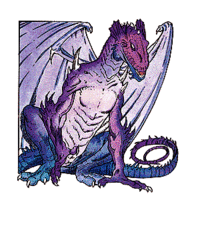
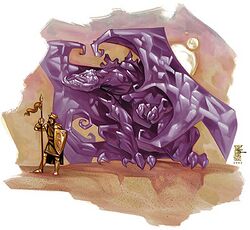
Diplomatic and easy-going by nature, the purple-hued amethyst dragons favor the psionic disciplines of psychokinesis and psychometabolism, although they also possess skills in telepathy and metapsionics. Feeding on fish and gemstones, their breath weapon is a "faceted lozenge" of violet-hued energy, which functions more like a fireball than the traditional draconic breath weapon. This kinetic glob is spat at a target point, whereupon it erupts in a powerful concussive force-blast that can knock creatures clean off their feet and blow down buildings like a bomb. Given their predominantly piscovorous diet, amethyst dragons favor the shores of isolated mountain lakes and pools, sometimes going so far as to dig out caves underwater to dwell - they have an instinctive ability to breathe water.
Although they much prefer to talk rather than fight, amethyst dragons are known for really disliking Red and White Dragons, and for regarding both Silver and Copper Dragons with some disdain.
In addition to its many psionic powers - a typical arsenal for an amethyst dragon consists of Detonate, Project Force, Telekinesis, Control Body, Inertial Barrier, Molecular Agiation, Complete Healing, Energy Containment, Metamorphosis, Cell Adjustment, Expansion, Reduction, Domination, Mind Link, Mind Wipe, Contact, ESP, Identity Penetration, Truthear, Empower, Psychic Surgery, Ultrablast, Magnify, Psionic Sense and Psionic Drain - an amethyst dragon always has a number of magical abilities as well. They can communicate with all creatures that have a spoken language, are immune to force and poison, and have access to various spell-like abilities as they age; Water Walking 6/day (Young), Neutralize Poison 6/day (Juvenile), Shape Change into a Reptile, Bird or Mammal, once per day for each (Adult), Otiluke's Resilient Sphere 3/day (Old), Reflecting Pool 1/day (Very Old) and Control Weather 1/day (Venerable).
Crystal Dragon
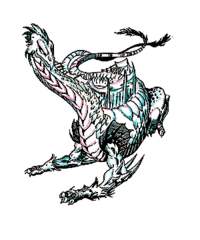
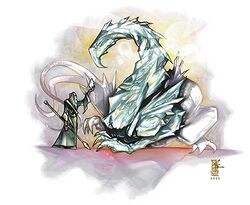
Easily distinguished by their lack of wings and spinal frill, the lizard-like crystal dragons are amongst the most friendly and gregarious of all the gem dragons, with their Chaotic Neutral tendencies fitting their intense curiosity about the world around them. Obviously, their psionics skill lies in the field of clairsentience, although they are amongst the weakest of the gem dragons. Born with glossy white scales, they turn increasingly translucent as the crystal dragon ages, which causes them to sparkle and glitter in any sort of light.
Needless to say, light is a pretty important theme in most of the crystal dragon's non-psionic abilities. Their breath weapon takes the form of a cone full of brilliantly glowing shards of razor-edged laser-light, which cuts, burns and potentially blinds their prey. Immune to both light-based attacks and cold environments, they can cast Charm Person at will from hatching, Color Spray 3/day as Juveniles, and Suggestion 3/day as Adults. Upon reaching the Very Old category, they can, once per day, pluck off a scale and make it function as per a Stone of Good Look for 1 hour per age category, which they like to give as gifts to friendly visitors. Finally, Crystal Wyrms can cast Control Winds 3 times per day.
For living spaces, they love open spaces with good, unrestricted skies for stargazing at night, and these are best in places where it's cold most of the time. Crystal dragons just adore snow, and prefer to spend their days playing in the snow - doing everything from making snow-forts and snow sculptures to throwing snowballs at people - and their nights watching the stars.
Though extremely friendly, white dragons don't appreciate their tendency to hang around in a territory they already have problems guarding from silver dragons. Likewise, the fact that giants often like to enslave them means they are the one race that crystal dragons can truly be said to hate.
Crystal dragons are known to prefer minerals in the forms of gems and metal ore over any other food-stuff.
Emerald Dragon

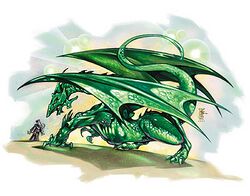
Known as the most paranoid of the gem dragons, emerald dragons use their innate affinity for telepathy and clairstentience to indulge their love of studying history without having to actually interact with other races. These scintillating green-scaled dragons favor lairing on extinct or rarely-active volcanoes, where they feed on lizards and giants - especially fire giants, whom they absolutely detest for some reason. Immune to sound-based attacks and with innate Flame Walking abilities, emerald dragons possess a medley of enchantment and fire-based spell-like abilities. Their breath weapon is a brain-scrambling sonic shriek.
Obsidian Dragon
Not one of the original five breeds of Gem Dragons, Obsidian Dragons were invented in 3rd edition as part of the Mind's Eye article series on the WotC website. These Gem Dragons are the most intelligent of their family, but also the most vicious; extremely haughty, easily angered and with a sadistic streak that manifests in a love of "toying" with their prey before finishing it off, their mandated alignment is Neutral Evil.
An obsidian dragon has smooth black skin with razor edges where joints come together. When first hatched, their scales are gray, rough to touch, and well defined. As they get older, the scales darken, become smoother, and begin to blend together. They have only the one breath weapon; a cone of fire, but they wield an array of innate psionics centered around telepathy and pyrokinesis. They also have the innate ability to Plane Shift at will between the Material Plane and the Inner Planes, with great wyrms developing the ability to use the psionic power Genesis.
Most obsidian dragons prefer to make their lairs around volcanoes or in one of the mountains of coal found on the Elemental Plane of Fire. Most great wyrms, though, make use of the genesis power to create their own demiplane.
Sapphire Dragon
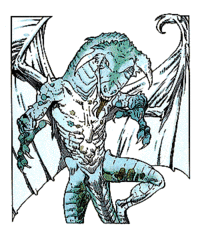
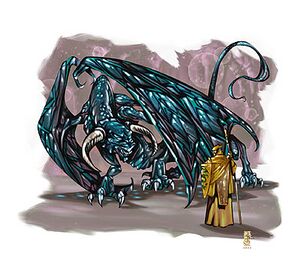
Naturally adept in clairsentience, psychokinesis and psychoportation (favoring the latter) and militantly territorial, few have any real hopes of sneaking up on a sapphire dragon. Favoring subterranean regions, these dragons are sometimes mistaken for blue dragons by those who either forget where the Chromatics live or fail to notice the difference in horns (blues have a single nasal horn, sapphires have two curved horns on the sides of their heads, like blacks). Despite how fiercely they protect their turf, unless you're a known hostile (such as a drow, duergar, aboleth or illithid), the sapphire's typical approach is to convince you to leave first, then attack if you won't go.
The breath weapon of sapphire dragon's is a conical sonic blast which also triggers deep fear in anyone who survives exposure to it. They are themselves immune to fear and movement restricting spells and effects, and have spell-like abilities useful in their subterranean existence.
They consider giant spiders to be a delicacy.
Topaz Dragon
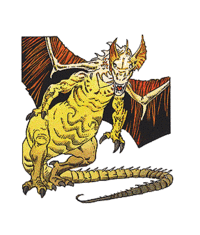

Unfriendly, selfish and highly erratic, the topaz dragons are perhaps the biggest jerks of the gem dragons, and certainly some of the least desireable to meet. Able to breathe water and immune to cold, their breath weapon is a ray that evaporates water, fatally desiccating living creatures caught in it. They also possess various spell-like abilities relating to manipulating water, which increase as they age. Native to oceanic coastlines, they have a peculiar enmity for bronze dragons and will attack them on sight, making them unique amongst the gem dragons in that regard.
Lesser Gem Dragons
Amber Dragon
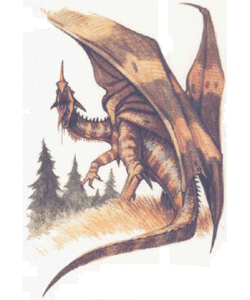
Denizens of the deep forest, amber dragons are "neutral" in the sense a force of nature is neutral; they just do what they like and don't give a shit about anyone else. Uniquely amongst dragons, they actually disdain material possessions, and so neither form hoards nor establish permanent lairs. Feeding on coniferous tree sap, they are territorial, but don't seek to actively protect nature as a driving goal. Still, they're apparently close enough to the balance for nature to reward them, given that all amber dragons can cast druidic spells. Their breath weapon is a conical gout of scalding hot tree sap, which rapidly solidifies into amber when exposed to cooler air.
Aside from being innate druidic casters, amber dragons also have the innate ability to magnetize people, can Shape Change like a 7th level druid 3/day, and Blink 1/day per 2 age categories.
Amber dragons have a distinctively "prow-like" triangular horn on their snouts; their teeth are too small to use for their primary food, or even to bite, so they gouge at trees with their horn and then lick up the sap that spills from the wounds. Their claws are particularly long and sharp, though, making formidable defensive tools.
This was the last of the Neutral Dragons to appear, debuting in the Monstrous Compendium Annual Volume 3.
Jacinth Dragon
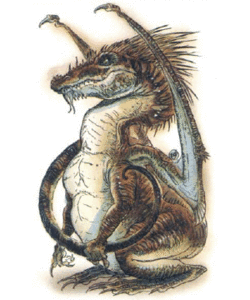
Distinguished by their shimmering, flame-bright orange hides, jacinth dragons are amongst the rarest of all gem dragons, something not helped by their natural preference for isolationism. Amongst the smallest of the dragons, to the point it negatively impacts on their fearful aura, they are nonetheless very magically powerful - their innate spellcasting ability gives them the combined spells and caster level of both a wizard and a cleric. They can't shapeshift, but they can Blink, as per a 10th level caster, 6 times a day.
Their scintillating hides have a hypnotic effect, which means that if a jacinth launches a betrayal-based surprise attack, it gets a bonus to the Surprise roll equal to the number of rounds it spent in a peaceful encounter beforehand. Furthermore, on a sunny day, spending more than two rounds looking straight at a jacinth dragon forces a creature to save vs. spells or be blinded for 5d6 rounds. Add in the ability to essentially hypnotize people at will, with a cumulative 10% chance per round spent listening to a jacinth dragon talking that they will affect any listener as per a Suggestion spell, and these are amongst the nastiest diplomancers in the dragon family.
The jacinth's breath weapon is a conical blast of scalding hot air, so intense that it burns flesh and can set things on fire.
This was one of the original trio of Neutral Dragons, debuting in the Monstrous Compendium Annual Volume 1.
Jade Dragon
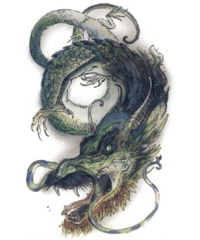
Described as an "oriental cousin" to the Emerald Dragon, jade dragons have the traditional "oriental dragon" body-structure - a wingless, four-limbed serpent with somewhat leonic facial features. Smaller and weaker than emerald dragons, and lacking their psionic powers, they possess the spellcasting ability of a multiclassed wizard/cleric and retain the deadly sonic shriek of their relatives. They can also hypnotize others simply by talking, much like the jacinth dragon, although with less aptitude. They also share the jacinth's inability to shapeshift without preparing spells in advance, and their ability to blink.
Living in deep forests, jade dragons favor jade and rare woods as the basis for their hoards. They strictly refuse to eat other sapient creatures, only consuming vegetation and animals, but are also quite antisocial.
This was one of the original trio of Neutral Dragons, debuting in the Monstrous Compendium Annual Volume 1.
Moonstone Dragon
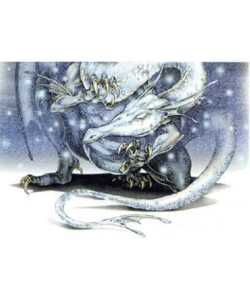
The largest of the lesser gem dragons, moonstone dragons normally dwell in the Plane of Faerie and the Plane of Dreams, or at least on the Ethereal Plane, very rarely coming to the material world. Interested predominantly in the affairs of the fey over that of humans, they have access to both wizardly and priestly spells (something that seems to be a running theme for Neutral Dragons), although restricted in what they can wield. They can use wizardly enchantment/charm and illusion spells, alteration spells of dim light and shadow, and spells of dreams and dreaming, as well as priestly spells from the spheres of all, healing, necromancy (good only), and divination.
These mystical dragons have an aura of awe rather than the standard aura of fear, which causes victims who fall prey to simply stand there and watch the dragon in awe, with all memories fading after the dragon flees. Which is easy for them to do, as they can become ethereal at will, unless bound in chains forged from gold. Their breath weapon is a billowing conical cloud of light motes, which nullifies magic and forces the victims to sleep whilst dulling their memories of meeting the moonstone dragon. They're known to be capable of breaching the damage resistance of almost any creature, but are vulnerable to elemental attacks and burn from exposure to sunlight or artificial light in much the same way as a vampire.
Little is known of moonstone dragons, but they may spend much of their time in the Ethereal Plane, or perhaps in lunar regions. Their existence is connected somehow with faerie settings; some guard these lands. In the most remote woodlands, persons attending the celebrations of a faerie court under a full moon might, in the morning, half-remember a chance encounter with one. The dragons usually shun the material world, but may try to influence it indirectly through agents.
Humans have encountered moonstone dragons in their dreams. Apparently, these creatures can enter a dreamscape at will. There, they speak the dreamer’s language, and may offer guidance or advice on matters concerning faeries, shadow, lunar matters, healing, and the like.
Their hoards are reputed to lie in faerie mounds or in secret woodland caverns. These have no copper or gold, but an equal value of silver or platinum pieces. Small beads of pure mithral are found instead of gems.
Moonstone dragons are thought to subsist on moonbeams and faerie nectar. They are not carnivorous, nor do they often kill. Among the legends of moonstone dragons are the following: Their tears are drops of mithral, from which the elves fashion chain mail; when one dies, it vanishes in a shower of moonbeams; when one dies well, its heart turns into a lump of purest adamantite. Further, it is said, if the dragon slays a creature unjustly, it turns into a pillar of sand, and its spirit is utterly destroyed.
Debuting in the Monstrous Compendium Annual Volume 2, this was the second-last Neutral Dragon to debut.
Pearl Dragon
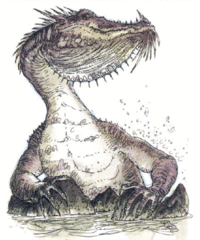
The wingless sea-dwelling pearl dragon is a creature content with the simple life, seeking to avoid trouble and feed on fish whilst gathering its beloved pearls. Unusually for an oceanic dragon, it has no innate water-breathing ability, and instead simply has an enormous capacity for holding its breath - over an hour at a time. They are quasi-nomadic, moving on as they deplete pearl beds in their territory, but because of their need to meticulously take every single piece from one lair to the other, transferring lairs takes a pretty damn long time, as you might expect.
Aside from their ability to breathe clouds of steam, hypnotize others through speech like a jade dragon, and Blink six time per day, pearl dragons have no real innate magic, although like most of their lesser gem dragon kindred they have access to the spellcasting abilities of a multiclassed wizard/cleric.
This was one of the original trio of Neutral Dragons, debuting in the Monstrous Compendium Annual Volume 1.
AD&D 2e Official Statblocks
- Amethyst
http://www.mojobob.com/roleplay/monstrousmanual/d/drageame.html
- Crystal
http://www.mojobob.com/roleplay/monstrousmanual/d/dragecry.html
- Emerald
http://www.mojobob.com/roleplay/monstrousmanual/d/drageeme.html
- Sapphire
http://www.mojobob.com/roleplay/monstrousmanual/d/dragesap.html
- Topaz
http://www.mojobob.com/roleplay/monstrousmanual/d/dragetop.html
- Amber
http://www.mojobob.com/roleplay/monstrousmanual/d/dragnamb.html
- Jacinth
http://www.mojobob.com/roleplay/monstrousmanual/d/dragnjac.html
- Jade
http://www.mojobob.com/roleplay/monstrousmanual/d/dragnjad.html
- Moonstone
http://www.mojobob.com/roleplay/monstrousmanual/d/dragnmoo.html
- Pearl
http://www.mojobob.com/roleplay/monstrousmanual/d/dragnpea.html
| The Dragons of Dungeons & Dragons | |
|---|---|
| Dragons | Albino Wyrm - Arcane Dragon - Aquatic Dragon - Brine Dragon - Catastrophic Dragon - Cerilian Dragon - Chromatic Dragon - Cloud Dragon - Cobra Dragon - Crimson Dragon - Deep Dragon - Dragonet - Epic Dragon - Faerie Dragon - Fang Dragon - Ferrous Dragon - Gem Dragon - Half-Dragon - Linnorm - Metallic Dragon - Minidragon - Mist Dragon - Moon Dragon - Obsidian Dragon - Oriental Dragon - Planar Dragon - Prismatic Dragon - Pseudodragon - Radiant Dragon - Red Hawk Dragon - Sand Dragon - Sea Wyrm - Shadow Dragon - Song Dragon - Stellar Dragon - Stone Dragon - Sun Dragon - Dragon Turtle |